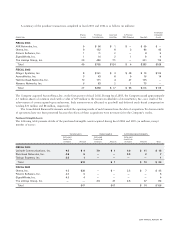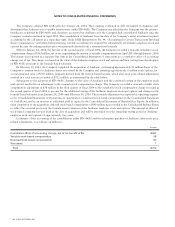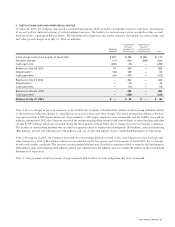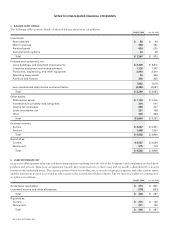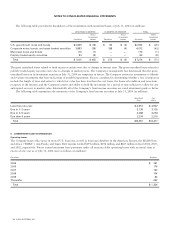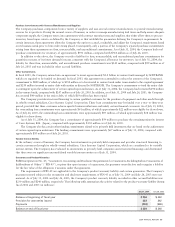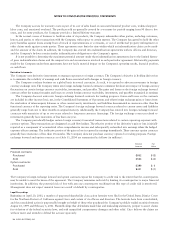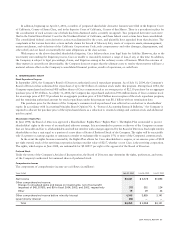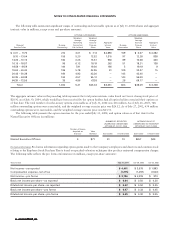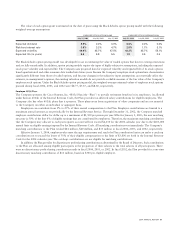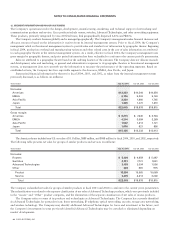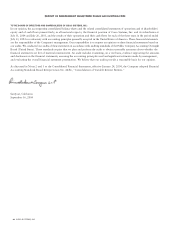Cisco 2004 Annual Report Download - page 53
Download and view the complete annual report
Please find page 53 of the 2004 Cisco annual report below. You can navigate through the pages in the report by either clicking on the pages listed below, or by using the keyword search tool below to find specific information within the annual report.
The Company accrues for warranty costs as part of its cost of sales based on associated material product costs, technical support
labor costs, and associated overhead. The products sold are generally covered by a warranty for periods ranging from 90 days to five
years, and for some products, the Company provides a limited lifetime warranty.
In the normal course of business to facilitate sales of its products, the Company indemnifies other parties, including customers,
lessors, and parties to other transactions with the Company, with respect to certain matters. The Company has agreed to hold the other
party harmless against losses arising from a breach of representations or covenants, or out of intellectual property infringement or
other claims made against certain parties. These agreements may limit the time within which an indemnification claim can be made
and the amount of the claim. In addition, the Company has entered into indemnification agreements with its officers and directors,
and the Company’s bylaws contain similar indemnification obligations to the Company’s agents.
It is not possible to determine the maximum potential amount under these indemnification agreements due to the limited history
of prior indemnification claims and the unique facts and circumstances involved in each particular agreement. Historically, payments
made by the Company under these agreements have not had a material impact on the Company’s operating results, financial position,
or cash flows.
Derivative Instruments
The Company uses derivative instruments to manage exposures to foreign currency. The Company’s objective in holding derivatives
is to minimize the volatility of earnings and cash flows associated with changes in foreign currency.
The Company conducts business on a global basis in several currencies. As such, it is exposed to adverse movements in foreign
currency exchange rates. The Company enters into foreign exchange forward contracts to minimize the short-term impact of foreign currency
fluctuations on certain foreign currency receivables, investments, and payables. The gains and losses on the foreign exchange forward
contracts offset the transaction gains and losses on certain foreign currency receivables, investments, and payables recognized in earnings.
The Company does not enter into foreign exchange forward contracts for trading purposes. Gains and losses on the contracts
are included in other income (loss), net, in the Consolidated Statements of Operations and offset foreign exchange gains or losses from
the revaluation of intercompany balances or other current assets, investments, and liabilities denominated in currencies other than the
functional currency of the reporting entity. The Company’s foreign exchange forward contracts related to current assets and liabilities
generally range from one to three months in original maturity. Additionally, the Company has entered into foreign exchange forward
contracts with maturities of up to two years related to long-term customer financings. The foreign exchange contracts related to
investments generally have maturities of less than one year.
The Company periodically hedges certain foreign currency forecasted transactions related to certain operating expenses with
currency options. These transactions are designated as cash flow hedges. The effective portion of the derivative’s gain or loss is initially
reported as a component of accumulated other comprehensive income and subsequently reclassified into earnings when the hedged
exposure affects earnings. The ineffective portion of the gain or loss is reported in earnings immediately. These currency option contracts
generally have maturities of less than 18 months. The Company does not purchase currency options for trading purposes. Foreign
exchange forward and option contracts as of July 31, 2004 are summarized as follows (in millions):
Notional Fair
Amount Value
Forward contracts:
Purchased $862 $ (3)
Sold $583 $ (2)
Option contracts:
Purchased $389 $ 6
Sold $431 $ (1)
The Company’s foreign exchange forward and option contracts expose the Company to credit risk to the extent that the counterparties
may be unable to meet the terms of the agreement. The Company minimizes such risk by limiting its counterparties to major financial
institutions. In addition, the potential risk of loss with any one counterparty resulting from this type of credit risk is monitored.
Management does not expect material losses as a result of default by counterparties.
Legal Proceedings
Beginning on April 20, 2001, a number of purported shareholder class action lawsuits were filed in the United States District Court
for the Northern District of California against Cisco and certain of its officers and directors. The lawsuits have been consolidated,
and the consolidated action is purportedly brought on behalf of those who purchased the Company’s publicly traded securities between
August 10, 1999 and February 6, 2001. Plaintiffs allege that defendants made false and misleading statements, purport to assert claims
for violations of the federal securities laws, and seek unspecified compensatory damages and other relief. Cisco believes the claims are
without merit and intends to defend the actions vigorously.
56 CISCO SYSTEMS, INC.
NOTES TO CONSOLIDATED FINANCIAL STATEMENTS



